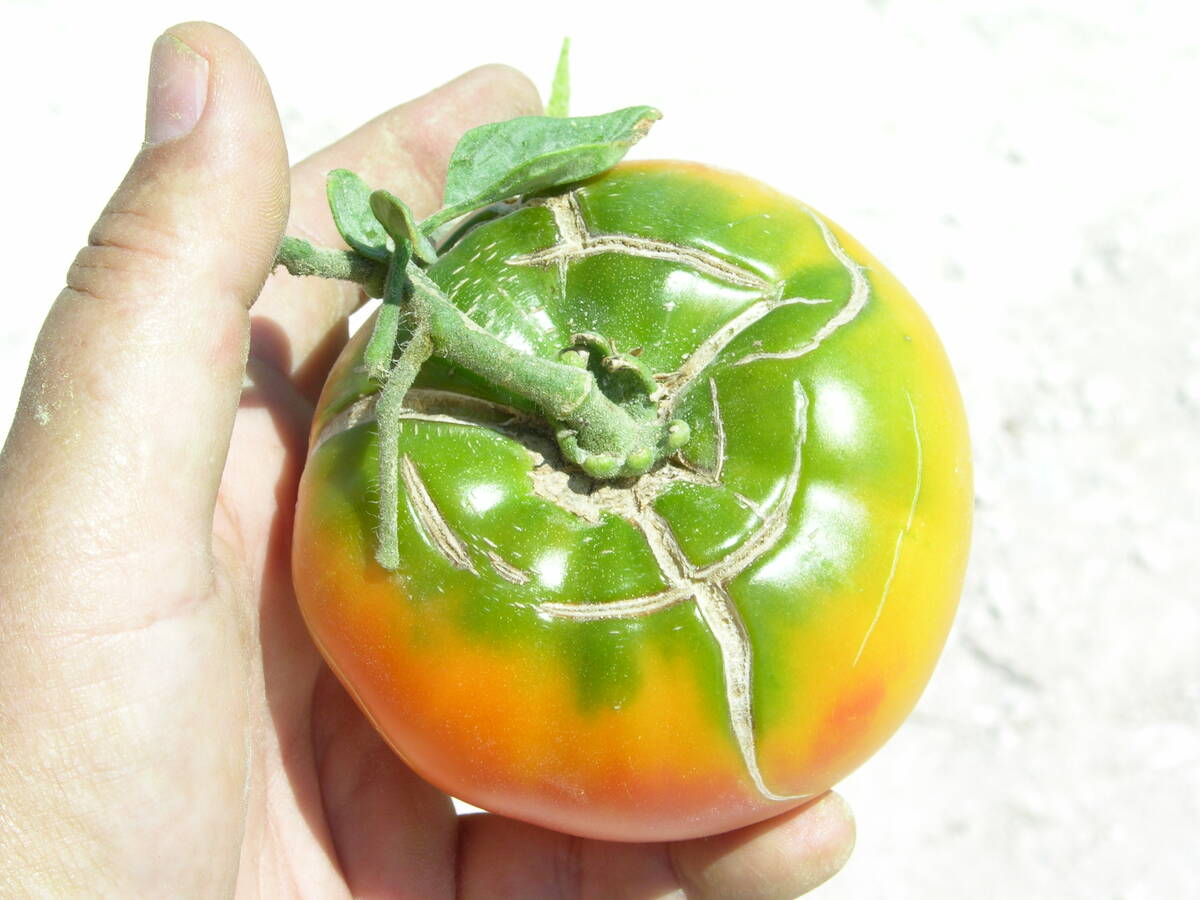Some tomato varieties show more radial cracks than others
Q: What causes cracks in the tomatoes near the top where the stem is? I have also seen some of my tomatoes with very deep cracks. Let me know what you can tell me about this.
A: There are two types of cracking, longitudinal cracks and radial cracking. Radial cracking is mostly a varietal issue. Some varieties of tomatoes show these radial cracks more than others.
If you have radial cracks, grow a different variety next season. That will lessen, but not eliminate, radial cracking.
Another possibility is uneven amounts of water to the fruit, which cause mostly longitudinal cracks. The swelling of the fruit and then shrinking back to its original size can cause cracking because of the expanding fruit. This type of cracking (longitudinal cracks again mostly) is lessened by using a surface mulch on top of the soil.
Sometimes watering differently will help. If you are using surface mulch, I would recommend wood or pine shavings — like rabbit, horse, or hamster bedding. It decomposes into the soil easier than straw, which has fibers that are tough to decompose. Straw works but is more difficult to get it to break down quickly.
You don’t need a thick layer of surface mulch but just enough to shade the ground and lessen water lost by soil surface evaporation.
Q: How deep are plant roots?
A: It depends on the size of the plant. That is because the roots of plants extend beyond their drip line.
Roots of plants have the potential of growing anywhere under a plant’s canopy. When a plant is surrounded by dry soil, applied irrigation is very important for root growth. So is air. Roots must breathe.
If you visually lay a plant on its side and spin a circle with it, that will roughly describe where its roots can grow when there is plenty of rain. That is not true in the desert. Even tall lawn grasses have shorter roots if they are watered and then mowed closer to the soil.
The functions of roots are not just to supply the top of the plant with water, but this plant must stay upright and resist the pushing of wind. This is one reason why tall plants have water that is applied deeper than shorter plants.
If the plant is small, water it only to 12 inches. Small plants don’t need as much support, and the water travels smaller distances.
Large trees and shrubs are watered as deep as 24 to 36 inches. Their roots must carry water a lot farther as well as keep these big plants upright under their weight and in the wind.
The water they need is applied to the soil deeper than when watering short plants. They need deep watering because the soil under the roots is dry. Deep roots are needed as the tree gets bigger because of its ever-increasing canopy size and weight.
The taller the plant, the deeper the plant’s roots are needed for transporting water and support.
As plants get larger, they need an increasing number of the same drip emitters to apply water to the soil. By adding more drip emitters, you can keep the minutes the same. With very large trees and shrubs, at some point you may need to increase the size of the emitters, as well as their numbers, to keep the minutes the same.
Q: My oleanders seem to be in decline. I noticed the stems are turning black on them and the branches seem to be dying. Any idea what I can do to turn them around?
A: Many reasons can cause stems to become black including death of the stems. If the stems are both brittle and have no leaves, then they might be dead. It’s best to check them.
If this were me, I would cut them back to about 1 or 2 inches above the soil level and let them grow back. Sometimes it’s not worth the time, effort and cost to experiment because the stems have turned black.
At the most water every other day and give the soil a chance to breathe. Daily watering in the summer is only for lawns, raised beds and annual flowers.
Q: We noticed that a couple of our ash trees are not doing well at all. I did a quick Google search yesterday and found an article you wrote about ash dieback. I’m hoping that’s not what is happening to our trees, but it does look like it.
The only other thing that might have happened is that my husband put sterilant down on some rocks nearby last November. Now we are wondering if perhaps the sterilant made its way down to tree roots that may have been growing beneath the rocks. I believe he treated the whole area with sterilant. If it is in fact a chemical injury to the trees, is there anything that can be done?
A: I don’t think your ash tree has this particular disease. After looking at the pictures you sent, I think it was caused by the sterilant.
It’s helpful if you can tell me the name of the sterilant used. Many sterilants are taken up by plant roots. The sterilant damage usually occurs on leaves and stems. On leaves, sometimes they scorch (their leaf margins will burn). This is what I think I see. In many cases, the leaves turn yellow or become bleached.
In the desert, tree roots follow water. Wherever water is applied, that’s where you will find its roots if this area is under its canopy.
I noticed a lawn under the tree. Did you kill a part of the lawn with sterilant? Many sterilants are taken up by plant roots, but this sterilant can oftentimes be seen in the leaves.
If it is sterilant damage, you can try a couple of things. First, try to wash it out. Putting a lot of extra water in that area might flush the sterilant out. Just remember to give a day or so without water to give a chance for the roots to breathe. Roots need both air and water to survive.
There is a chance that putting activated charcoal may help, but it depends on the sterilant used.
When there is consistent rainfall, roots of trees extend all through the soil under its so-called canopy. Your ash tree grows in a lawn. Watering lawns is more even, regular and consistent than rainfall.
Ash trees do remarkably well in lawns. In my opinion that is their preferred way of getting water to the roots.
Ash trees infected with ash decline are not getting enough water to the dying limbs. This disease plugs the water-conducting vessels in tree limbs. As this disease slowly gets worse, more and more limbs begin dying because of a lack of water. The homeowner ends up removing the tree because it looks ugly.
To see if your tree has this disease or not, give it some extra water once a week during the summer. An extra irrigation during the week tells you if the tree has this disease or not. If the tree does not improve in a few weeks with this extra irrigation, then assume the tree has the disease.
The mistake made by most homeowners, in my opinion, is not removing the tree as soon as they decide one way or another. If you have confirmed this disease, then remove the tree as soon as possible. This tree can spread this disease to other ash trees.
Q: My fruit trees were doing so well, and then they started to get rusty leaves. They are on the east side of the house.
A: First of all, your trees appear to be newly planted and small. You may not have enough yearly and seasonal experience in our desert to tell if it’s normal or not for your trees. Next, there was a lot of unusual weather this spring. Keep that in mind.
Rake surface mulch or rock away from the trunk 3 feet in every direction. Next, apply some surface compost to this area and mix it into the soil 3 to 4 inches deep. It’s OK to use a garden rake to do it.
Water this entire area several times so that the water gets about 6 inches deep or so. Use wood chips to cover the exposed area.
To me, this looks like a disease problem left over from the wet spring we had this year. Perhaps shothole fungus.
If that is the case, some peaches and nectarines have inherent disease problems associated with the variety that was used. You may have to replace these trees with different varieties that are not as susceptible to this disease if it persists year after year.
Make sure your trees get enough water and the water is applied to a wide area under the canopy of the tree. If your tree will fit into a 5-gallon nursery container, give it 5 gallons. If your tree would fit into a 15-gallon nursery container, then give it 8 to 10 gallons of water.
During the summer, apply this amount of water slowly around the base of the tree (or capture it in a moat) three times a week. During the winter months of late December and January, water it once every seven to 10 days.
Bob Morris is a horticulture expert and professor emeritus of the University of Nevada, Las Vegas. Visit his blog at xtremehorticulture.blogspot.com. Send questions to Extremehort@aol.com.























